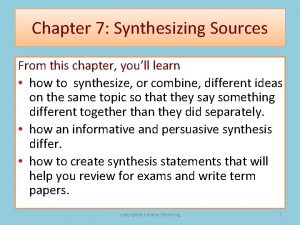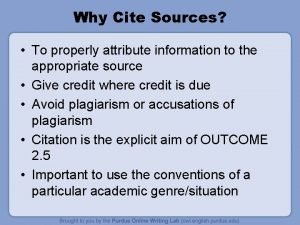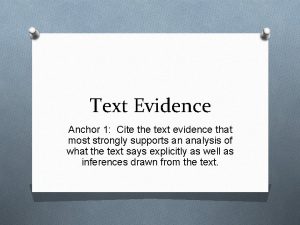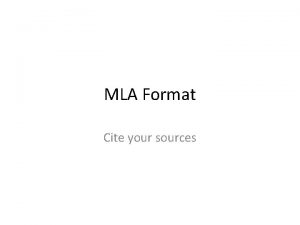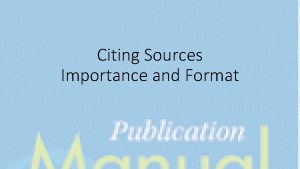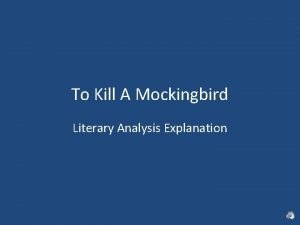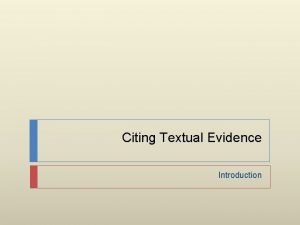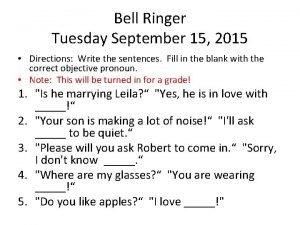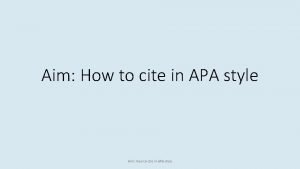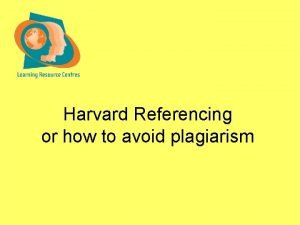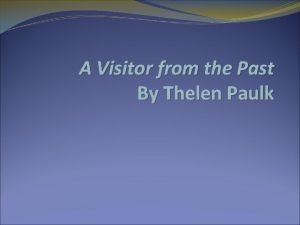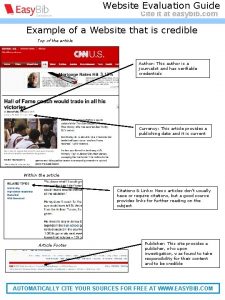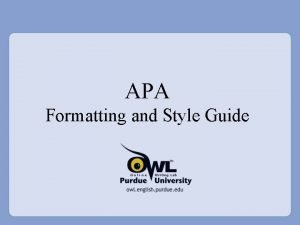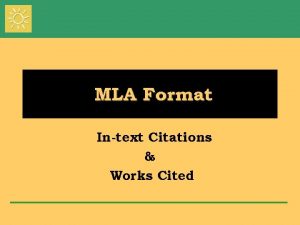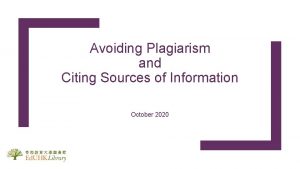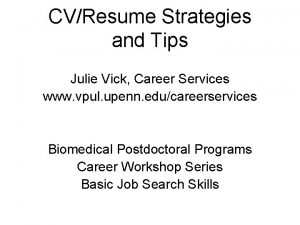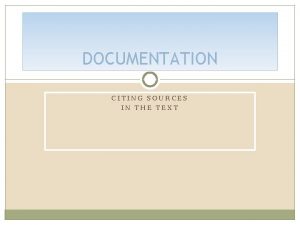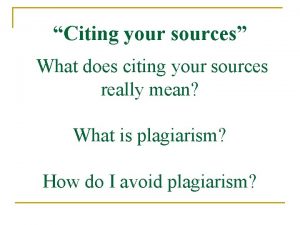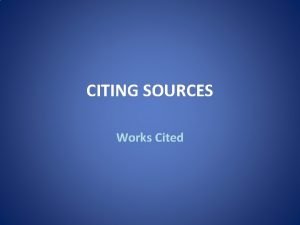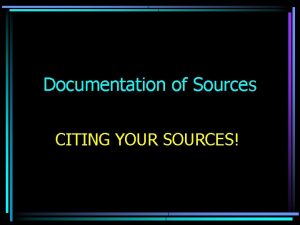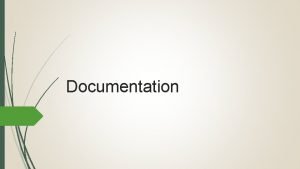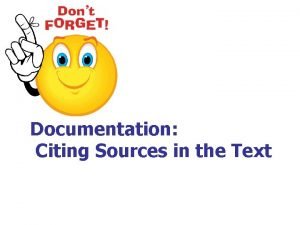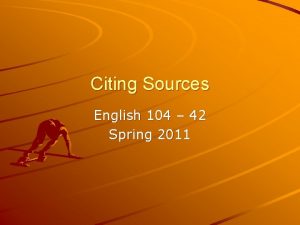Documentation Citing Sources in the Text It is





















- Slides: 21

Documentation: Citing Sources in the Text

-It is important to indicate to the readers, not only what works you used in the writing the paper, but also what you took from each. - The most practical way to do that is to insert a brief parenthetical acknowledgment in your paper ; usually the author’s name and a page reference.

Information Required in Parenthetical Documentation: 1 -The information in your parenthetical references in the text must match the corresponding information in the list of work cited: *When the list contains only one work by the author cited, you need to give only the author’s last name (Crosby 170) * If the list contains more than one author with the same last name, you must add the first initial – (A. Hulme 90) and (J. Hulme 124) Or if the initial is shared too, the full first name.

* If two or three names begin the entry, give the last name of each person listed: (Joyce, Gilbert, and Morgan 66) * If the work has more than three authors, give the author’s last name followed by et al: (Scott et al 201 - 55) * If there is a corporate author, use shortened or full name: (Psychologists Committee 65) * If the work is listed by the title, use the title, shortened or in full: (‘’Analysis’’ 27)

Readability - Give only the parenthetical information needed to identify a source and avoid unnecessary parenthetical additions. Example: Example If you are citing an entire work, rather than a specific part of it, the author’s name maybe the only documentation needed and no need for parenthetical documentations. e. g. “Spearman has devoted his entire article for this subject’’

There is a direct relation between what you integrate into your text and what you place in parentheses. For example, if you include the author’s name in a sentence, you need not to repeat it in the parentheses that follow. Example: AUTHOR’S NAME IN THE TEXT: Dennison has elaborated on this idea (186). AUTHOR’S NAME NOT IN THE TEXT: This point has been already debated. (Dennison 186).

- - To avoid interruption of the flow of your writing, place the parenthetical reference where a pause would naturally occur ( preferably at the end of the sentence), and as near as possible to the material documented A reference directly after a quotation follows the closing quotation mark: “During Austen’s life, English life was regulated by central rather than local authority” (Smith 322).

- If the quotation, whether of poetry or prose (long quotation), is set off (indented) from the text, type space after the concluding punctuation mark of the quotation and insert the parenthetical reference: Somewhere ages and ages hence: two roads diverged in a wood, and I— I took the one less traveled by, And that has made all the difference. (Frost 6 -9)

3 - When you borrow from a source several times in succession, you may give a single parenthetical reference after the last borrowing: Romeo and Juliet presents an opposition between two worlds: “the world of the everyday and the world of romance. ” Although the two lovers are part of the world of romance, their language of love nevertheless become “fully responsive to the tang of actuality” (Zender 137, 200)

In-Text Citations: the Basics ØQuote only words or phrases that are important to the writing ØAccuracy is extremely important. Quotes must be exactly like the original source – do not change the spelling, punctuation, capitalization or any of the words ØYou may paraphrase the quotation and rewrite it in your own words, but make sure you include the correct documentation at the end.

Author’s last name Parenthetical Notes: Author-Page # Style In-text Example: Wordsworth stated that Romantic poetry was marked by a Page "spontaneous overflow of powerful feelings" (263). number Romantic poetry is characterized by the "spontaneous overflow of powerful feelings" (Wordsworth 263). Wordsworth extensively explored the role of emotion in the creative process (263). Corresponding Works Cited Entry: No comma Wordsworth, William. Lyrical Ballads. London: Oxford U. P. , 1967.

Print Source with Author In-text Example: Human beings have been described by Kenneth Burke as "symbolusing animals" (3). Human beings have been described as "symbol-using animals" (Burke 3). Corresponding Works Cited Entry: Burke, Kenneth. Language as Symbolic Action: Essays on Life, Literature, and Method. Berkeley: U of California P, 1966.

With Unknown Author In-text Example: We see so many global warming hotspots in North America likely because this region has “more readily accessible climatic data and more comprehensive programs to monitor and study environmental change. . . ” (“Impact of Global Warming” 6). Corresponding Works Cited Entry: “The Impact of Global Warming in North America. ” GLOBAL WARMING: Early Signs. 1999. 23 Mar. 2009. www. climatehotmap. org/namerica. html.

Other In-Text Citations 1 Authors with Same Last Names In-text Example: Although some medical scientists claim that cloning will lead to designer children (R. Miller 12), others note that the advantages for medical research outweigh this consideration (A. Miller 46). Works Cited List Entries: Miller, Amy. Who’s Afraid of Designer Babies? Chicago: Rand, 2009. Miller, Richard. Designer Babies: Ethical Considerations. New York: Random House, 2005.

Other In-Text Citations 2 Work by Multiple Authors In-text Examples: Smith, Yang, and Moore argue that tougher gun control is not needed in the United States (76). The authors state "Tighter gun control in the United States erodes Second Amendment rights" (Smith, Yang, and Moore 76). Jones et al. disagree with Smith, Yang, and Moore's argument, noting the current spike in gun violence in America compels law makers to adjust gun laws (4). ‘et al. ’ means ‘and others’ used for more than three authors

Other In-Text Citations 3 Multiple Works by the Same Author In-text Examples: Lightenor has argued that computers are not useful tools for small children ("Too Soon" 38), though he has acknowledged elsewhere that early exposure to computer games does lead to better small motor skill development in a child's second and third year ("Hand. Eye Development" 17). Visual studies, because it is such a new discipline, may be "too easy" (Elkins, "Visual Studies" 63). A new author who also has more than one work used in the paper

Other In-Text Citations 4 Citing Multivolume Works In-text Example: . . . as quoted in The Encyclopedia Britannica (1: 14 -17). Citing Indirect Sources Volume no: Page numbers In-text Example: Ravitch argues that high schools are pressured to act as "social service centers, and they don't do that well" (qtd. in Weisman 259). Multiple Citations The information by Ravitch is in the book by Weisman In-text Example: . . . as has been discussed elsewhere (Burke 3; Dewey 21). Same information can be found in two different sources

Other In-Text Citations 5 Sources from the Internet An ellipsis … indicates that some words have been removed In-text Example: One online film critic stated that Fitzcarraldo is ". . . a beautiful and terrifying critique of obsession and colonialism" (Garcia, “Herzog: a Life”). Corresponding Works Cited Entry: Garcia, Elizabeth. "Herzog: a Life. " Online Film Critics Corner. The Film School of New Hampshire, 2 May 2002. <http: //www. filmnewhampshire. edu/criticscorner>. 8 Jan. 2009.

Changing Quoted Material n Enclose a changed letter in square brackets n n Original = “The court decided to …” Modified = Moreover, “[t]he court decided to …” Original = “In the latter event, the court decided to …” Modified = “[T]he court decided to …”

Substituting or Adding Words n n Instead of changing one letter, it sometimes you need to replace the entire word. If you substitute or add words to a quotation, enclose those words in square brackets. n Original = “The court waited for Mr. Jamison. ” n Changed = “The court waited for [the witness]. ”

Mistakes within Original Quoted Material n n Original material may contain mistakes, such as spelling and grammatical errors. Old texts might use archaic spelling or grammar that is no longer considered correct. n You may correct all mistakes and place square brackets around the corrections you made. n You may use [sic] to show the error appears in the original. n n The book suggests that the reader begins “with a [description] of the original work. ” The book suggests that the reader begins “with a desscription [sic] of the original work. ”
 Synthesizing sources
Synthesizing sources In text citation example
In text citation example Text evidence sentence starters
Text evidence sentence starters How to cite a source mla
How to cite a source mla Importance of citing evidence
Importance of citing evidence Making connections
Making connections To kill a mockingbird literary analysis prompts
To kill a mockingbird literary analysis prompts How to introduce textual evidence
How to introduce textual evidence Sentence starters for evidence
Sentence starters for evidence Water management importance
Water management importance Print and web sources
Print and web sources How to apa cite a website with no author
How to apa cite a website with no author Harvard referencing citing
Harvard referencing citing Citing poetry
Citing poetry Citing
Citing Apa website citation no author
Apa website citation no author Whats mla format
Whats mla format How to quote a play in an essay mla
How to quote a play in an essay mla Citing
Citing What is textual evidence? *
What is textual evidence? * Citing publications in resume
Citing publications in resume Difference between citation and reference
Difference between citation and reference
